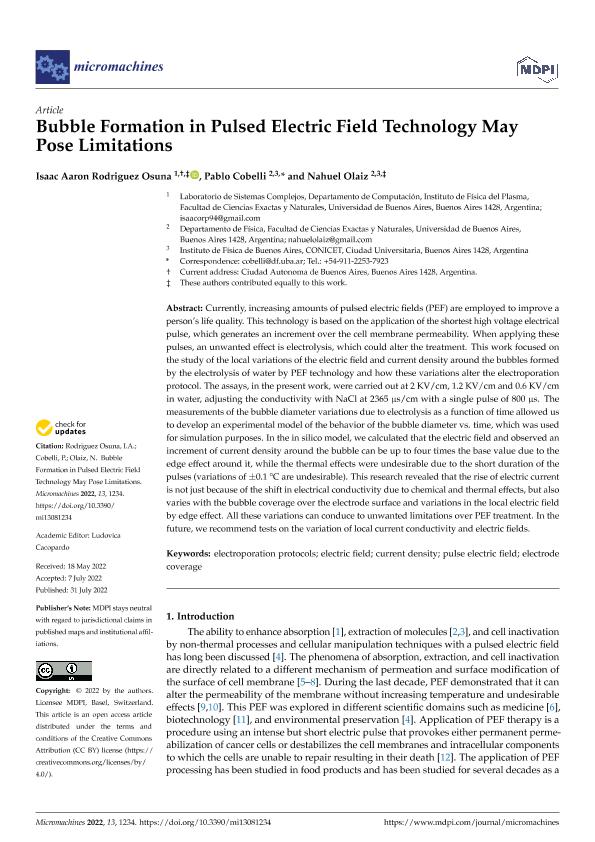Mostrar el registro sencillo del ítem
dc.contributor.author
Rodriguez Osuna, Isaac Aaron

dc.contributor.author
Cobelli, Pablo Javier

dc.contributor.author
Olaiz, Nahuel Manuel

dc.date.available
2023-10-02T17:44:29Z
dc.date.issued
2022-08
dc.identifier.citation
Rodriguez Osuna, Isaac Aaron; Cobelli, Pablo Javier; Olaiz, Nahuel Manuel; Bubble Formation in Pulsed Electric Field Technology May Pose Limitations; MDPI; Micromachines; 13; 8; 8-2022; 1-10
dc.identifier.issn
2072-666X
dc.identifier.uri
http://hdl.handle.net/11336/213814
dc.description.abstract
Currently, increasing amounts of pulsed electric fields (PEF) are employed to improve a person’s life quality. This technology is based on the application of the shortest high voltage electrical pulse, which generates an increment over the cell membrane permeability. When applying these pulses, an unwanted effect is electrolysis, which could alter the treatment. This work focused on the study of the local variations of the electric field and current density around the bubbles formed by the electrolysis of water by PEF technology and how these variations alter the electroporation protocol. The assays, in the present work, were carried out at 2 KV/cm, 1.2 KV/cm and 0.6 KV/cm in water, adjusting the conductivity with NaCl at 2365 μs/cm with a single pulse of 800 μs. The measurements of the bubble diameter variations due to electrolysis as a function of time allowed us to develop an experimental model of the behavior of the bubble diameter vs. time, which was used for simulation purposes. In the in silico model, we calculated that the electric field and observed an increment of current density around the bubble can be up to four times the base value due to the edge effect around it, while the thermal effects were undesirable due to the short duration of the pulses (variations of ±0.1 °C are undesirable). This research revealed that the rise of electric current is not just because of the shift in electrical conductivity due to chemical and thermal effects, but also varies with the bubble coverage over the electrode surface and variations in the local electric field by edge effect. All these variations can conduce to unwanted limitations over PEF treatment. In the future, we recommend tests on the variation of local current conductivity and electric fields.
dc.format
application/pdf
dc.language.iso
eng
dc.publisher
MDPI
dc.rights
info:eu-repo/semantics/openAccess
dc.rights.uri
https://creativecommons.org/licenses/by/2.5/ar/
dc.subject
CURRENT DENSITY
dc.subject
ELECTRIC FIELD
dc.subject
ELECTRODE COVERAGE
dc.subject
ELECTROPORATION PROTOCOLS
dc.subject
PULSE ELECTRIC FIELD
dc.subject.classification
Físico-Química, Ciencia de los Polímeros, Electroquímica

dc.subject.classification
Ciencias Químicas

dc.subject.classification
CIENCIAS NATURALES Y EXACTAS

dc.title
Bubble Formation in Pulsed Electric Field Technology May Pose Limitations
dc.type
info:eu-repo/semantics/article
dc.type
info:ar-repo/semantics/artículo
dc.type
info:eu-repo/semantics/publishedVersion
dc.date.updated
2023-07-07T22:39:19Z
dc.journal.volume
13
dc.journal.number
8
dc.journal.pagination
1-10
dc.journal.pais
Argentina

dc.description.fil
Fil: Rodriguez Osuna, Isaac Aaron. Consejo Nacional de Investigaciones Científicas y Técnicas. Oficina de Coordinación Administrativa Ciudad Universitaria. Instituto de Física del Plasma. Universidad de Buenos Aires. Facultad de Ciencias Exactas y Naturales. Instituto de Física del Plasma; Argentina
dc.description.fil
Fil: Cobelli, Pablo Javier. Consejo Nacional de Investigaciones Científicas y Técnicas. Oficina de Coordinación Administrativa Ciudad Universitaria. Instituto de Física de Buenos Aires. Universidad de Buenos Aires. Facultad de Ciencias Exactas y Naturales. Instituto de Física de Buenos Aires; Argentina
dc.description.fil
Fil: Olaiz, Nahuel Manuel. Consejo Nacional de Investigaciones Científicas y Técnicas. Oficina de Coordinación Administrativa Ciudad Universitaria. Instituto de Física de Buenos Aires. Universidad de Buenos Aires. Facultad de Ciencias Exactas y Naturales. Instituto de Física de Buenos Aires; Argentina
dc.journal.title
Micromachines
dc.relation.alternativeid
info:eu-repo/semantics/altIdentifier/doi/http://dx.doi.org/10.3390/mi13081234
Archivos asociados
